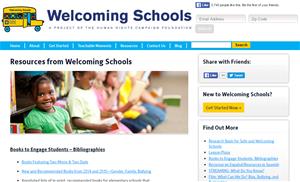This article is a supplement to “Curating Empathy,” a feature in the May/June issue of Literacy Today, ILA’s member magazine.
 There are simple steps anyone can take to expand the diversity in their classroom library and incorporate LGBT books.
There are simple steps anyone can take to expand the diversity in their classroom library and incorporate LGBT books.
For our youngest students (pre-K–3), begin with books that demonstrate diverse families of all kinds. Some books to start with are The Great Big Book of Families by Mary Hoffman (Dial) and The Family Book by Todd Parr (Little, Brown Books). Also make sure to include books that specifically describe LGBT families such as And Tango Makes Three by Justin Richardson and Peter Parnell (Simon & Schuster) and Heather Has Two Mommies by Lesléa Newman (Candlewick).
For slightly older students (grades 4–5), more complex picture books such as In Our Mothers’ House by Patricia Polacco (Philomel) allow teachers to read books out loud that promote discussion and conversation about LGBT families.
There is an incredible amount of chapter books that are about LGBT characters and families. There is also an increasing number of books that just happen to have LGBT characters included. For wonderful suggestions, visit the Human Rights Campaign’s Welcoming Schools book list.
Make sure not to forget about characters and people who are transgender. In recent years, some powerful books have been published. For younger students, picture books such as I Am Jazz by Jessica Herthel and Jazz Jennings (Dial) and Jacob’s New Dress by Sarah and Ian Hoffman (Albert Whitman) are great places to start. For older elementary and junior high school students, George by Alex Gino (Scholastic) and Gracefully Grayson by Ami Polonsky (Disney-Hyperion) are incredible choices. There is also a wide range of YA books that include transgender characters. A great list can be found on the YALSA website.
Try to find other colleagues who also want to add books with LGBT characters into their classrooms. Making change together is always easier than doing it on your own.
As you work together, keep the following in mind:
- Before reading books for the first time, acknowledge that it might be uncomfortable for some students. Let them know that it is OK and that you are reading these books to help all of you learn about the world.
- Talk about the books you add. Don’t let them sit there untouched. Talk about them, recommend them, get kids interested in them. The kids will take it from there.
- Use books for reasons other than just to teach about LGBT people.
- Include nonfiction and fiction books.
- Do not keep these books in a separate section. This reinforces the idea that there is something different and separate and even controversial about LGBT people.
- If uncertain about whether content is appropriate, ask yourself if the same book containing a straight couple instead of a gay or lesbian couple would be appropriate. If yes, then the book should also be appropriate for your students.
 Jessica Lifshitz teaches fifth grade at Meadowbrook Elementary School in Illinois. She is passionate about literacy and believes reading and writing can make this world a better place. She writes about her teaching and learning on her blog.
Jessica Lifshitz teaches fifth grade at Meadowbrook Elementary School in Illinois. She is passionate about literacy and believes reading and writing can make this world a better place. She writes about her teaching and learning on her blog.